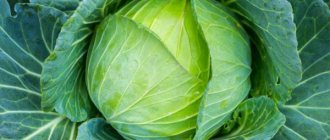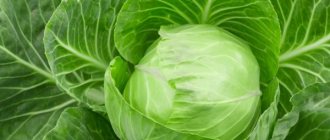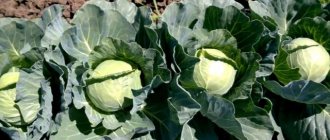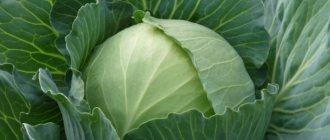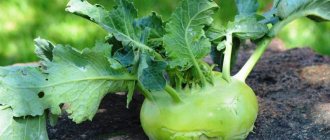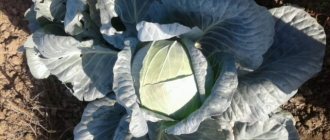Description of the variety
The cabbage variety Stone Head was bred in Poland about 20 years ago. Since then, it has been invariably popular among summer residents throughout the former USSR, but especially in Russia, Ukraine and Moldova. The variety is a late-ripening variety; the heads of cabbage are fully formed by October.
The shape of the head of cabbage is round, slightly flattened on top. Less typical, but also found, is the plano-convex form. The average weight of one head of cabbage is 2–4 kg. If you create ideal conditions for cabbage, it will increase to 5–6 kg.
The rosette of leaves is not too wide - 65–80 cm in diameter. But there are also specimens with a rosette up to 100–110 cm. The lower leaves are slightly raised. The upper leaves covering the head of cabbage are light green; in cross section it is white. The stalk is small, the veins on the leaves are thin. It is characterized by a dense structure; there are practically no voids between the leaves, so even heads of cabbage that are small in diameter are quite heavy.
From the moment the seedlings are planted in the ground until harvest, 110–125 days pass. If you plant cabbage from seeds, the growing season is 140–160 days.
The variety is quite productive - on average, 8–10 kg of cabbage is harvested from 1 m². If you grow this crop on an industrial scale, you can count on 850–900 centners per hectare.
Stone head cabbage owes its popularity to its versatility, keeping quality and relative unpretentiousness.
Advantages and disadvantages
Among the undoubted advantages of the variety are the following:
- Taste qualities. Cabbage can be eaten fresh, used for preparing first and second courses, and stored for the winter. This versatility comes from its high sugar content.
- Dense structure of heads of cabbage.
- Resistant to cracking during ripening.
- Cold resistance.
- Drought resistance. The variety is specially adapted to hot, dry weather.
- Disease resistance. Stone head is practically not susceptible to fusarium and is rarely affected by rot.
- Transportability. Cabbage does not lose any of its marketability or consumer qualities when transported over long distances.
- Long shelf life. If storage conditions are observed, by the end of winter the taste improves noticeably.
Hard and not very juicy leaves are sometimes noted as a disadvantage. But this is a distinctive feature of all late-ripening cabbage varieties.
How to store and use correctly
The descriptions of the variety indicate that it is universal in cooking - in general, this is true. But, as reviews from gardeners and chefs show, this variety is not as good when fresh as after processing. Stone head is surprisingly good for pickling, pickling or pickling.
Vegetables are stored wonderfully - the main thing is to comply with several conditions:
- Pick cabbage on a nice, sunny day. After collecting, place it in a dry place and let it lie and dry so that the heads of cabbage are not wet. This way they will last longer.
- Collect fruits in special boxes or in cardboard boxes or bags. It is important that air can easily pass through this material. But cabbage cannot be stored in plastic bags, like any other vegetables.
- Of course, this is obvious, but I’ll write it just in case - cabbage should be stored in the refrigerator or cellar, in a dark place protected from light.
How to plant Stone Head cabbage?
Most often, ready-made seedlings are planted in the ground. For areas with a temperate climate, this method allows you to protect plants from spring frosts, which are by no means uncommon in these areas. In addition, Stone Head is a late variety, so if the seeds do not sprout, there is no point in sowing them a second time.
Late varieties of cabbage are rarely planted directly into the ground with seeds: this is due to the unpredictability of the domestic climate.
Since the Stone Head needs to be planted in a permanent place at the end of May or early June, the optimal time for sowing seeds for seedlings is the first ten days of April. You can add a tablespoon of simple superphosphate and a glass of wood ash to the soil for every 10 liters. The seeds are sown shallowly - 0.5-1 cm, covered with film or glass and placed in a place with a temperature of 15-18ºC, providing enough light. Shoots should appear in about a week.
Caring for seedlings involves regular watering. When the second true leaf appears, feed the cabbage with a mixture of ammonium nitrate, superphosphate and potassium sulfate (20, 40 and 10 g per 10 liters of water). After 10 days - the second feeding. The norm is increased to 30, 60 and 20 g, respectively. It is undesirable to feed seedlings with manure, so as not to provoke the development of root rot.
Despite the fact that the seedlings are quite small, the hole for planting is made deeper: fertilizers must also be placed there
It is best to plant cabbage on a cloudy, but not frosty or rainy day. It is buried in the ground down to the first true leaf. To protect against pests, nourish and neutralize soil acidity, add a handful of ground eggshells and/or wood ash and humus to the hole. The hole should be quite deep (13–18 cm).
An important point is choosing a suitable location. This cabbage variety grows best in loamy soils with a neutral acidity level. It is good to plant cabbage in lowlands where groundwater comes close to the surface. Also, plants are extremely demanding of sunlight; even the slightest shading is not allowed. It’s good if crops from the nightshade family, pumpkin, legumes, onions or grains grew in the garden before. It is not advisable to constantly grow cabbage in the same place. At least once every 3-4 years you need to change the bed.
There should be no cucumbers, tomatoes, pumpkins, celery and onions in neighboring beds. Like cabbage, they pull a lot of nutrients from the soil. Spinach, which requires frequent, abundant watering, is also undesirable.
At the time of planting, normally developing bushes should have at least 5 true leaves and be about 15 cm tall. Overgrown seedlings, like underdeveloped ones, do not take root well. 10–12 days before planting, they begin to harden it by exposing it to fresh air every day for a couple of hours.
It is better to plant Stone Head cabbage immediately in separate containers, so as not to waste time and effort on diving later
Between every two bushes and between the rows, leave 65–70 cm. Otherwise, care becomes much more difficult and there are not enough nutrients for everyone. In principle, the Stone Head is frost-resistant and can withstand a short-term drop in temperature down to -5ºC, but it is better to have covering material on hand in order to protect the seedlings in time. It is better to also cover newly planted bushes, for example, with coniferous branches, to protect the delicate leaves from sunburn.
Video: features of growing late varieties of cabbage
Features of cultivation
There are two planting methods:
- seedling;
- seeds.
Note! The first is suitable for planting in central Russia, the second - in the southern regions of the country.
Seedling method
In order to have time to harvest cabbage before the first frost, you need to sow the seeds in the first half of April. Seedlings ready for transplanting must have at least five developed leaves and reach 15 cm in length.
Seedlings are planted in the ground in late spring - early summer.
It is necessary to plant the bushes at a distance of 50 cm from each other, and leave 60 cm between the rows.
Before sending seedlings into open ground, they must become stronger
Seedless method
When planting plant seeds in the ground, it is necessary to take into account local climatic conditions, including soil temperature. The first landing is carried out in early May, and the backup batch is left until the next time. If weather disasters are not expected, then the next landing is carried out in a week.
Rules of care
After cabbage seedlings are planted in open ground, caring for them includes regular loosening of the soil, weeding, watering and fertilizing.
Loosening the soil
18–20 days after planting in the ground, cabbage is hilled for the first time. After another 10–12 days, repeat the procedure. When hilling, you cover the stem with soil, encouraging it to form new roots. Cabbage will be able to absorb more nutrients from the soil.
Around each bush you need to form a “protective barrier” at least 12–14 cm wide
In the future, loosening will suffice. The soil should be loosened every time after rain to a depth of 8–10 cm. If there has been no rain, loosening is carried out once a week. Be careful not to damage the roots and petioles of the leaves.
Watering
Cabbage of the Stone Head variety is drought-resistant, but this does not mean that it can not be watered at all. In general, any cabbage is extremely demanding on soil moisture. Watering should be especially abundant in the first 12–16 days after planting in the ground. Every 2 days, at least 7–8 liters of water should be poured per 1 m². Use water that is not too cold, at room temperature. The optimal time is early morning or late evening. It is best to use special sprinklers for watering young seedlings. If this is not possible, dig shallow trenches parallel to the planting rows and carefully pour water into them. After this time, watering can be reduced. Now 10 liters per 1 m² every week is enough.
When the cabbage is strong enough (from mid-July), you can water not the bed, but the plant itself. At first, you can limit yourself to 1–1.5 liters at the root, then increase the norm to 3–4 liters when the heads of cabbage begin to set (for the Stone Head this is August). Watering is adjusted depending on weather conditions.
Watering is stopped 2–3 weeks before harvest. Sufficient natural precipitation. Although manufacturers describe the Stone Head variety as resistant to head cracking, it is better to play it safe. Another way to prevent cracking is to tie it tightly, bend it, or cut the stem about a third of the thickness. In this case, the flow of nutrients to the heads of cabbage will be sharply reduced, and their growth will slow down.
Fertilizers
Cabbage is very sensitive to the presence of nutrients and microelements in the soil. Therefore, exceeding their dosage is extremely undesirable. But it’s also impossible to grow crops without fertilizers. On average, cabbage of late varieties, which includes the Stone Head, needs to be fed four times per season:
- 16–18 days after disembarkation. Use any complex fertilizer for cabbage (Effecton, Zdraven, Sudarushka, Agricola). Most often they are produced in liquid form. For 10 liters of water, 30–40 ml of product is quite enough. The resulting infusion is poured over the cabbage at the rate of 0.5 liters per bush. At this time, the crop intensively forms green mass, so nitrogen is needed. Ammonium nitrate (10 g per 10 liters of water) is suitable.
- 10–12 days after the first. Dilute 0.5 liters of fresh cow manure or 200 ml of bird droppings in 10 liters of water, mix thoroughly and water the plants. If cabbage does not grow well, you can add 15–20 ml of Kemira-Lux. An alternative to organics is superphosphate (20 g), urea and potassium nitrate (10 g each) per 10 liters of water.
- At the end of June. Feed the cabbage with potassium and phosphorus so that heads of cabbage set. Superphosphate and potassium sulfate are suitable (40 and 20 g per 10 liters of water, respectively). If superphosphate is double, the rate is halved. 7–8 liters of fertilizer are poured onto 1 m² of bed.
- Third ten days of August. Complex nitrogen-phosphorus-potassium fertilizer (Autumn, Nitrophoska, Diammofoska, AVA). The norm is the same as in the previous case.
In addition to the fact that cabbage is tasty and healthy, it is also valued as a plant for flower beds. In Japan, its ornamental varieties are considered simply irreplaceable in the fall, when most other plants have already faded.
Video: white cabbage seedlings and caring for them
Advantages and disadvantages
Like any other variety of vegetable, Stone Head has its own advantages and disadvantages.
Main advantages of the type:
- versatility of use;
- cold resistance;
- dense fruit structure;
- high resistance to fusarium and rot;
- long storage period;
- resistance to cracking of heads of cabbage;
- possibility of transportation without loss of commercial qualities.
The only drawback of the species is the hard leaves, so the variety lacks juiciness.
White cabbage of the Stone Head variety is the optimal type of crop for long-term storage. At the same time, it is absolutely undemanding in care, which allows you to grow a good harvest of vegetables without any special difficulties.
Diseases and pests
From a botanical point of view, cabbage is a biennial plant. The head of cabbage, which is cut in the fall, is a bud well adapted to wintering. The next year, seed pods would form in it.
Stone head cabbage is quite resistant to diseases caused by fungi and bacteria. For example, it is practically not susceptible to fusarium and relatively rarely suffers from rot. But not a single breeder is able to protect the new variety from slugs and insects.
There are simple preventive measures that will significantly reduce the risk of pests and diseases affecting your cabbage:
- Seed disinfection. Immediately before sowing, they are dipped in a container with hot (45–50ºС) water and left for a quarter of an hour. Then immediately place it in a container with cold (18–20ºС) water for 3–4 minutes. Heat and cold kill most bacteria and fungal spores. After this, the seeds are laid out on napkins or paper towels to dry slightly.
- Optimal temperature and humidity when growing seedlings. Excessive heat and water-logged soil promote the development of rot.
- Rejection. At the slightest sign of disease, damaged plants are immediately removed and destroyed.
- Use of insecticides. To protect the roots of young plants, before planting seedlings in the ground, they are coated with a mixture of Karbofos, clay and fresh manure, diluted with water to the consistency of thick sour cream.
- Growing other crops to attract natural enemies of insect pests and repel them. Most insects do not like strong odors, so next to cabbage you can plant marigolds, calendula, wormwood, mint, lemon balm, rosemary, and sage. Natural enemies (ladybugs, ground beetles, tannin fly and ernestia fly) feed on nectar. They especially love tansy, dill, caraway seeds, decorative onions, fennel and other umbelliferous plants.
But prevention cannot provide a complete guarantee that the crop will not suffer from diseases and pests. Therefore, it is important to be able to distinguish symptoms in time, identify the cause and know how to deal with the problem.
Table: diseases and pests
| Problem | Symptoms | Control and prevention measures |
| Root rot ("black leg") | Newly hatched sprouts or seedlings turn black at the base of the stem. Afterwards the stem darkens completely and the plant dies. |
|
| White and gray rot |
|
|
| Mosaic disease |
| There is no effective way to get rid of the problem. As a preventative measure, regular and thorough weeding of the beds is recommended. All plants with the slightest signs of damage are immediately pulled out and destroyed. |
| Rhizoctoniosis |
|
|
| Kila | Plants dry out and die for no apparent reason. If you pull them out of the ground, multiple dense brown small growths are visible on the roots. | All dried plants are immediately removed and burned. The bed is watered with a solution of colloidal sulfur (40 g per 10 liters of water). You can simply sprinkle it with powder (5 g per 1 m²) and loosen the soil well. |
| Caterpillars of cabbage butterflies, white moths and cutworms |
|
|
| Aphid | It settles on the underside of the leaf, forming entire colonies and sucking out the juice. Damaged leaves turn pale and curl. |
|
| Cabbage moth | The caterpillars gnaw holes in the leaves, but the outside of the leaf is not damaged. Long tubercles are clearly visible on the upper and lower sides of the leaf. | It is recommended to spray with Karbofos solution (60–65 g per 10 liters of water). Treatment must be carried out at least twice with an interval of 10–12 days. No later than a month before harvesting, spraying is stopped. |
| Cabbage fly |
|
|
| Slugs |
|
|
What do the most common cabbage diseases look like? (photo gallery)
There are almost no clubroot-resistant cabbage varieties.
To combat rhizoctonia, use any preparations based on copper oxychloride
Mosaic disease cannot be treated: you can only destroy the affected plants
All types of rot first affect the stem and leaf petioles
Blackleg can destroy crops already at the seedling stage
Harvesting
You can begin harvesting the Stone Head cabbage variety in early or mid-October, depending on the climate in the region. It is advisable to choose a dry day for harvesting cabbage, without rain or fog, since excess moisture is an ideal breeding ground for the proliferation of all types of fungi and bacteria. This, in turn, significantly reduces the shelf life of cabbage. For the same reason, it is not recommended to start harvesting in the early morning or late evening, when the heads of cabbage are covered with dew.
It is better not to take risks and not wait for the first frost. The optimal temperature for harvesting is 5–7ºС. Cabbage damaged by frost should be used immediately or canned. Whole heads of cabbage will not last long. But cabbage harvested in warm weather (10–15ºС) does not store well because it withers.
If you nevertheless missed the moment and the cabbage was “grabbed” by frost, you do not need to immediately place the cabbages removed from the garden in a warm place. The upper leaves will turn into a solid, unpleasantly slimy mass. It is better to place the heads of cabbage in a room with a temperature slightly above 0ºC and cover with a blanket or other thick fabric. However, if you plan to ferment cabbage, on the contrary, you need to wait for slightly negative temperatures (-3–5ºС). This way it will acquire the necessary sugar content. But you shouldn’t wait until -20–25ºС.
The cabbage variety Stone Head can be stored in proper conditions for 7–8 months, almost until the next harvest. Practice shows that long-term storage does not affect taste in any way. On the contrary, they are only getting better.
When harvesting cabbage intended for long-term storage, the stalk is cut with a sharp knife disinfected in a deep purple solution of potassium permanganate, holding it strictly perpendicular (the cut should be straight). There is no need to cut the stalk just below the head - leave about 8–12 cm. Before storing the heads of cabbage, coat the stalk with clay or wrap it in paper. Plastic film will not work - in this case, condensation will inevitably form.
It is not recommended to remove all outer leaves. Remove only dried, wilted or rotten ones. Leaving 3-4 covering leaves contributes to better preservation of cabbage. When they turn yellow or dry out (January-February), they need to be carefully cut off.
Then the cabbage is placed in a dark, dry room with good ventilation, in which the temperature is maintained at 0–5ºC. Cabbage reacts extremely negatively to sudden changes in temperature and humidity. The heads of cabbage are not placed too tightly in wooden boxes or cardboard boxes, sprinkled with dry sawdust, sand, straw or small pieces of paper. You can simply lay out the cabbage on wooden pallets or shelves, but in no case on the floor. It is useful to sprinkle the heads of cabbage a little with crushed chalk or sifted wood ash. This is additional protection against all types of rot.
The ideal storage option is to use wooden boxes
If you want to save space, you can stretch a rope under the ceiling of a garage, shed, or cellar and hang the heads of cabbage on it, tying them by the stalks.
For those who have a lot of space, the following method is suitable. Heads of cabbage are pulled out of the garden by the roots, all yellow, dry and rotten leaves are removed and “planted” for the winter in boxes with sand.
However, the Stone Head is not only suitable for long-term storage. The vast majority of gardeners and gardeners who grow it note the wonderful taste of sauerkraut, salted and pickled cabbage. Soups, main courses, pies and other culinary delights are no worse.
Sour cabbage is a Chinese invention. It was chopped and soaked in rice wine. This dish was then fed to those who were busy building the Great Wall of China.
Advantages and disadvantages
Most of the characteristics that cabbage received from its “parents” brought the variety incredible popularity.
Main advantages:
- Versatility of use in the kitchen along with high taste.
- Cabbage can withstand hot, dry weather without damage.
- A sudden cold snap does not affect the formation of a head of cabbage.
- During long-term transportation, cabbage does not get crushed or crack.
- Dense heads of cabbage are stored until the end of winter. At the same time, the taste only improves.
- Cabbage is not a hybrid. At home, it is possible to obtain fruits and high-quality planting material.
Excessive rigidity of the leaves is noted as a disadvantage.
Reviews from gardeners
I take seedlings of this cabbage because of the density of the heads, nothing less than stone.
Anna
https://pomidorchik.com.ua/ovoshi/semena-kapusty/kapusta-kamennaja-golova/reviews
I really like the taste of this variety of sauerkraut. My wife makes excellent sauerkraut; it contains many times more vitamins than fresh cabbage.
Vladimir Zaichenko
https://pomidorchik.com.ua/ovoshi/semena-kapusty/kapusta-kamennaja-golova/reviews
An excellent variety for long-term storage - proven over the years! It's also good at pickling. Seed germination and seedling survival rate are good. I recommend.
Osipchuk Elena Vyacheslavovna
https://agro-market.net/catalog/item/335
I grow this variety for winter storage. I have been buying seeds from the same seller for three years now. I am satisfied with the cooperation. Cabbage is well fermented and pickled, and is also stored in the cellar.
Evgenia Stepanovna
https://pomidorchik.com.ua/ovoshi/semena-kapusty/kapusta-kamennaja-golova/reviews
For those who provide their family with cabbage for the winter, I recommend the Stone Head variety. I will say that it lies well. At least better than some other varieties. We will sow it this year too.
Pavlo
https://pomidorchik.com.ua/ovoshi/semena-kapusty/kapusta-kamennaja-golova/reviews
This year I planted it for the first time to test. I really liked it so far, I don’t know how it’s been lying down. The heads of cabbage are large (2–4 kg), different, but very dense, truly “STONE”. Does not crack, juicy, crispy. I will plant. I recommend.
Svintsova Tatyana
https://agro-market.net/catalog/item/335
One of the most popular late-ripening varieties. The growing season is 150–160 days, the yield is up to 10 kg/m². The head of cabbage is round, dense, and white when cut. Resistant to cracking. It has increased shelf life and transportability. The taste is excellent. Indispensable for fermentation.
Let It Be
https://forumsadovodov.com.ua/viewtopic.php?p=878
Cabbage Stone Head is a late-ripening variety that does not lose quality during transportation. If proper conditions are met, it can be stored until next summer. The characteristics of the vegetable are such that Stone Head cabbage can be grown in countries with temperate climates. This led to the popularity of the variety among Russian gardeners and gardeners.
- Author: Yulia Golova
27 years old, higher legal education, broad outlook and interest in a variety of topics. Rate this article:
- 5
- 4
- 3
- 2
- 1
(1 vote, average: 5 out of 5)
Share with your friends!
Tips and reviews from experienced gardeners
Vegetable growers confirm the advantages of growing Sugarloaf cabbage and point out minor disadvantages of the variety.
Anastasia, Rostov: “In the summer we have little rain, so I was looking for a drought-resistant cabbage variety. The seller recommended Sugarloaf. My hopes were completely justified. I watered it once every 7-8 days, and that was enough. The heads of cabbage grew round and dense. The harvest was collected immediately after frost. The cabbage lasted until the end of spring. I am very pleased with the variety and recommend it to everyone!”
Olesya, Tomsk: “For our climatic conditions, it is difficult to find a variety of cabbage that will be tasty, ripen late and be stored for a long time at the same time. Sugarloaf meets all the qualities. She is also easy to care for. There are some cracked heads of cabbage, but they are good for pickling.”

